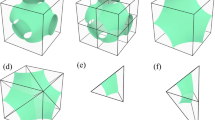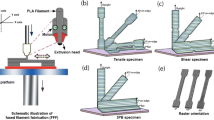Abstract
Three-dimensional concrete printing is a transformative technology ushering in revolutionary architectural design and construction automation changes. With recent advancements of this technology, a notable absence of theoretical models predicting structural buildability is required. This investigation aims to bridge this knowledge gap by introducing an innovative theoretical model for estimating the total number of layers printed by a concrete 3D printer. This proposed model considers material behavior, building rate, and failure criteria. The material properties are depicted by modeling structural buildability in two cases, (i) bilinear and (ii) exponential. The buildability is characterized by three subcases, namely (i) constant, (ii) increasing, and (iii) decreasing building rates. These subcases hinge on printing velocity, treated as a function of time. Furthermore, the failure modes of 3D printable concrete structures are delineated based on (i) the Mohr–Coulomb theory and (ii) elastic and plastic failure criteria. Additionally, a strength-correction factor is employed to consider the confinement effect of the printed layer. The ultimate expression of the proposed model embodies an exponential approach to gauging the structural buildability of the printed structures. The study encompasses model validation and extensive parametric analysis to scrutinize the impact of printing velocity, structuration rate, printing path, density, and yield stress.
















Similar content being viewed by others
Data Availability
No datasets were generated or analysed during the current study.
Code Availability
Not applicable
References
de Mendonça Filho, F.F., Chen, Y., Çopuroğlu, O.: Nano-modification in digital manufacturing of cementitious composites. In: Recent Advances in Nano-Tailored Multi-Functional Cementitious Composites, pp. 251–275. Elsevier, Amsterdam (2022)
Eugenin, C., Navarrete, I., Brevis, W., Lopez, M.: Air bubbles as an admixture for printable concrete: a review of the rheological effect of entrained air. 3D Printing and Additive Manufacturing 9, 64–80 (2022)
Giridhar, G., Prem, P.R., Jiao, D.: Effect of varying shear rates at different resting times on the rheology of 3D printable concrete. In: Materials Today: Proceedings (2023)
Giridhar, G., Prem, P.R., Kumar, S.: Development of concrete mixes for 3D printing using simple tools and techniques. Sādhanā 48, 16 (2023)
Golewski, G.L., Szostak, B.: Strength and microstructure of composites with cement matrixes modified by fly ash and active seeds of C-S-H phase. Struct. Eng. Mech. 82, 125426 (2021)
Hakeem, I.Y., Amin, M., Abdelsalam, B.A., Tayeh, B.A., Althoey, F., Agwa, I.S.: Effects of nano-silica and micro-steel fiber on the engineering properties of ultra-high performance concrete. Struct. Eng. Mech. 82, 295–312 (2022)
Hojati, M., Nazarian, S., Duarte, J.P., Radlinska, A., Ashrafi, N., Craveiro, F., Bilén, S.: 3D printing of concrete: a continuous exploration of mix design and printing process. In: 42nd IAHS World Congress the Housing for the Dignity of Mankind (2018)
Jayathilakage, R., Rajeev, P., Sanjayan, J.: Yield stress criteria to assess the buildability of 3D concrete printing. Constr. Build. Mater. 240, 117989 (2020)
Jayathilakage, R., Rajeev, P., Sanjayan, J.: Extrusion rheometer for 3D concrete printing. Cem. Concr. Compos. 121, 104075 (2021)
Jiao, D., De Schryver, R., Shi, C., De Schutter, G.: Thixotropic structural build-up of cement-based materials: a state-of-the-art review. Cem. Concr. Compos. 122, 104152 (2021)
Jiao, D., Shi, C., De Schutter, G.: Magneto-rheology control in 3D concrete printing: a rheological attempt. Mater. Lett. 309, 131374 (2022)
Kaliyavaradhan, S.K., Ambily, P., Prem, P.R., Ghodke, S.B.: Test methods for 3D printable concrete. Autom. Constr. 142, 104529 (2022)
Koksal, F., Bacanli, C., Benli, A., Gencel, O.: Fresh, flexural and mechanical performance of polyamide and polypropylene based macro-synthetic fiber-reinforced concretes. Struct. Eng. Mech. 82, 93–105 (2022)
Kruger, J., Zeranka, S., van Zijl, G.: An ab initio approach for thixotropy characterisation of (nanoparticle-infused) 3D printable concrete. Constr. Build. Mater. 224, 372–386 (2019)
Kruger, J., Zeranka, S., van Zijl, G.: 3D concrete printing: a lower bound analytical model for buildability performance quantification. Autom. Constr. 106, 102904 (2019)
Lafhaj, Z., Rabenantoandro, A.Z., el Moussaoui, S., Dakhli, Z., Youssef, N.: Experimental approach for printability assessment: toward a practical decision-making framework of printability for cementitious materials. Buildings 9, 245 (2019)
Lecompte, T., Perrot, A.: Non-linear modeling of yield stress increase due to scc structural build-up at rest. Cem. Concr. Res. 92, 92–97 (2017)
Liu, C., Xiong, Y., Chen, Y., Jia, L., Ma, L., Deng, Z., Wang, Z., Chen, C., Banthia, N., Zhang, Y.: Effect of sulphoaluminate cement on fresh and hardened properties of 3D printing foamed concrete. Composites, Part B, Eng. 232, 109619 (2022)
Long, W.-J., Tao, J.-L., Lin, C., Gu, Y.-c., Mei, L., Duan, H.-B., Xing, F.: Rheology and buildability of sustainable cement-based composites containing micro-crystalline cellulose for 3D-printing. J. Clean. Prod. 239, 118054 (2019)
Lyu, F., Zhao, D., Hou, X., Sun, L., Zhang, Q.: Overview of the development of 3D-printing concrete: a review. Appl. Sci. 11, 9822 (2021)
Ma, S., Qian, Y., Kawashima, S.: Experimental and modeling study on the non-linear structural build-up of fresh cement pastes incorporating viscosity modifying admixtures. Cem. Concr. Res. 108, 1–9 (2018)
Murcia, D.H., Genedy, M., Taha, M.R.: Examining the significance of infill printing pattern on the anisotropy of 3D printed concrete. Constr. Build. Mater. 262, 120559 (2020)
Nazar, S., Yang, J., Thomas, B.S., Azim, I., Rehman, S.K.U.: Rheological properties of cementitious composites with and without nano-materials: a comprehensive review. J. Clean. Prod. 272, 122701 (2020)
Perrot, A., Pierre, A., Vitaloni, S., Picandet, V.: Prediction of lateral form pressure exerted by concrete at low casting rates. Mater. Struct. 48, 2315–2322 (2015)
Perrot, A., Rangeard, D., Pierre, A.: Structural built-up of cement-based materials used for 3D-printing extrusion techniques. Mater. Struct. 49, 1213–1220 (2016)
Prem, P.R., Savija, B.: Gaussian models for bond strength evaluation of ribbed steel bars in concrete. Struct. Eng. Mech. 84, 651–664 (2022)
Prem, P.R., Sanker, A.P., Sebastian, S., Kaliyavaradhan, S.K.: A review on application of acoustic emission testing during additive manufacturing. J. Nondestruct. Eval. 42(4), 96 (2023)
Ravichandran, D., Giridhar, G., kumar Ramamurthy, V., Prem, P.R.: Influence of test protocol on determining the rheological properties of cement pastes mixtures for concrete 3d printing. In: Materials Today: Proceedings (2023)
Roussel, N.: A thixotropy model for fresh fluid concretes: theory, validation and applications. Cem. Concr. Res. 36, 1797–1806 (2006)
Suiker, A.S., Wolfs, R.J., Lucas, S.M., Salet, T.A.: Elastic buckling and plastic collapse during 3D concrete printing. Cem. Concr. Res. 135, 106016 (2020)
Tripathi, A., Nair, S.A., Neithalath, N.: A comprehensive analysis of buildability of 3D-printed concrete and the use of bi-linear stress-strain criterion-based failure curves towards their prediction. Cem. Concr. Compos. 128, 104424 (2022)
Weng, Y., Lu, B., Li, M., Liu, Z., Tan, M.J., Qian, S.: Empirical models to predict rheological properties of fiber reinforced cementitious composites for 3D printing. Constr. Build. Mater. 189, 676–685 (2018)
Wolfs, R.J., Bos, F., Salet, T.: Early age mechanical behaviour of 3D printed concrete: numerical modelling and experimental testing. Cem. Concr. Res. 106, 103–116 (2018)
Wolfs, R., Bos, F., Salet, T.: Triaxial compression testing on early age concrete for numerical analysis of 3D concrete printing. Cem. Concr. Compos. 104, 103344 (2019)
Wu, Y., Liu, C., Liu, H., Zhang, Z., He, C., Liu, S., Zhang, R., Wang, Y., Bai, G.: Study on the rheology and buildability of 3D printed concrete with recycled coarse aggregates. J. Build. Eng. 42, 103030 (2021)
Yuan, Q., Shi, C., Jiao, D.: Rheology of Fresh Cement-Based Materials: Fundamentals, Measurements, and Applications. CRC Press, Boca Raton (2022)
Acknowledgements
This research paper has been assigned the registration number CSIR-SERC-1011/2023. A grant from CSIR, New Delhi, funds this study.
Funding
Not applicable
Author information
Authors and Affiliations
Contributions
(i) Prabhat Ranjan Prem: Conceptualization, Methodology, Writing, Review, and Editing (ii) Parukutty Ambily: Writing, Review, and Editing (iii) Shankar Kumar: Conceptualization, Methodology, Writing, Review, and Editing (iv) Swapnil Balasaheb Ghodke: Writing, Review, and Editing
Corresponding author
Ethics declarations
Ethics approval
Not applicable
Consent to participate
Not applicable
Consent for publication
Not applicable
Declarations
The permission to reproduce figures or tables from other sources is taken from the original publishers or copyright holders. Suitable acknowledgment of the source has also been made by including the source in the reference list.
Competing interests
The authors declare no competing interests.
Additional information
Publisher’s Note
Springer Nature remains neutral with regard to jurisdictional claims in published maps and institutional affiliations.
Rights and permissions
Springer Nature or its licensor (e.g. a society or other partner) holds exclusive rights to this article under a publishing agreement with the author(s) or other rightsholder(s); author self-archiving of the accepted manuscript version of this article is solely governed by the terms of such publishing agreement and applicable law.
About this article
Cite this article
Prem, P.R., Ambily, P.S., Kumar, S. et al. A theoretical model to predict the structural buildability of 3D printable concrete. Mech Time-Depend Mater (2024). https://doi.org/10.1007/s11043-024-09666-8
Received:
Accepted:
Published:
DOI: https://doi.org/10.1007/s11043-024-09666-8




